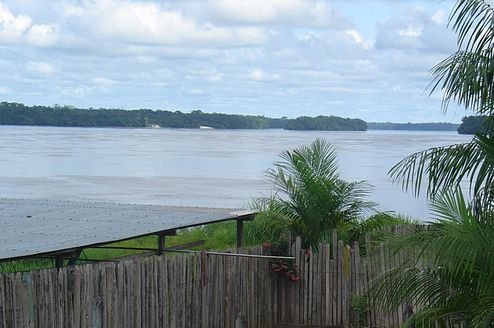By: Giovanni Giacalone and André L. V. C. Carvalho.

On January 3rd, 2022, Colombia’s Attorney General’s Office announced the arrest of five men in Colombia’s southern department of Putumayo. The detained individuals are now facing drug trafficking charges as they are accused of running their own marijuana plantations and cocaine labs in Colombia’s department of Cauca and using the local indigenous communities to transfer the drugs near the Colombia/Brazil border before having it shipped across to Brazilian territory by boat.
During the operations, the police seized over $250,000,000 from the organization, together with a large quantity of cocaine, marijuana, and three cargo carriers.
The Attorney’s office also revealed the identities of the arrested individuals: Medardo Alfredo Cifuentes Giraldo “Gordo”, in charge of coordinating the purchase, storage, and concealment of the merchandise, as well as handling transactions on the Colombian-Brazilian border; Wilmer Alexander Bastidas Bernal “Engineer”, indicated by investigators as the financial link; Kelly Johana Gómez Gómez “Mona”, allegedly responsible for recruiting transporters and guards at the collection centers; Pablo Giovanny Landázuri Cortés “Negro”, one of the alleged drug producers; and Víctor Ferney Giraldo Barrera, “Vaca”, who is credited with transporting the drug.
The Attorney General’s Office also revealed that the drug loads were supposed to be sold to major criminal enterprises operating in Brazil, such as Comando Vermelho (CV) - one of the oldest criminal organizations of Brazil -, and Família do Norte (FDN), the biggest organization of the Amazon region, with chapters in Peru, Venezuela and Colombia.
Over 900 km of border between the two countries in the dense Amazon jungle, make it extremely difficult to control illegal trafficking, and rivers such as the Putumayo, Rio Caqueta, Vaupes, and Rio Apaporis have become major ways of transit for illegal substances.
As exposed by InsightCrime, while much of the drug flow into Brazil comes from Bolivia and Paraguay, the Colombia connection has become increasingly relevant. This aspect should not be underestimated since in the past few years, Brazilian narco-organizations have become major exporters of drugs to Europe. As explained to Reuters by custom inspector Oswaldo Dias, in less than a decade Brazil’s drug gangs have risen from domestic street sellers to major international players in the drug business, using Santos and other ports to ship narcotics, mainly to Europe, with a value of over $10 billion only for the European market. The phenomenon was confirmed by Laurent Laniel, a senior analyst at the European Monitoring Centre for Drugs and Drug Addiction (EMCDDA).
As to Colombia, the ongoing clashes near the tormented border with Venezuela between ELN and FARC over illegal business control, with the Colombian army having to send reinforcements, surely doesn’t help the central government as it swallows up resources that could be used to control the southern part of the border with Brazil.
Additionally, the Colombian government has to deal with the increasing activity of the Urabeños drug cartel and paramilitary group and specifically with its franchise-like model of trafficking that relies on local gangs with no formal links to the cartel as they are simply sub-contracted to operate for them, in their name. (ITSS exposed the Urabeños drug cartel activity in November 2021).
According to the aforementioned, the drug trafficking flow into Brazil comes in most part from Bolivia and Paraguay. Although ties between Brazilian and Colombian criminal enterprises are not new, they have been growing in the last year and the impacts on the security in the region are starkly.
In 2017, investigations conducted by the Brazilian Federal Police and the Federal Prosecutor of the Amazon region pointed to a ‘strictly close’ relationship between the FDN and the FARC. The FDN operates primarily in the North region and has control over the main drug flow routes in the triple border region between Brazil, Colombia and Peru. Moreover, according to the reports, the organization used its connections with the Colombian partners to trade drugs and buy heavy weaponry to be used in Brazil.
However, the FDN is not the only one. Both the CV and the Primeiro Comando da Capital (PCC) – the two biggest criminal enterprises in Brazil - have also been strengthening their ties with Colombian organizations for a number of years. In 2019, the Army Chief of Staff of Colombia reported that the ELN had entered into a partnership with CV with the aim of facilitating drug trafficking (especially cocaine) in the Amazon region, specifically on the border between Leticia (Colombia) and Tabatinga (Brazil), using the Solimões River to provide an outlet for cocaine trafficking.
The success of these organizations is due to an outdated patrolling system, which, when associated with the complex geography of the region, allows them to easily escape from army platoons and federal police units. Among other things, the partnership with Colombian cartels provided Brazilian organizations with heavy weaponry and high-quality navigation equipment and vessels, often superior to security forces in the region. Currently, the 1,632km Brazil-Colombia route is practically uninhabited and unprotected, a fact that drives its growth every year. A clear example is that in recent years, the volume of drugs seized in the region has grown by no less than 1,324%.
This generates a series of other problems for security in the region, since in addition to the existing alliance between Brazilian and Colombian organizations there is also a war for the control of the main trafficking flows. In 2017, with the help of weapons provided by Colombian organizations, the FDN murdered more than 60 members of rival factions that were at war over the flow of cocaine. In this way, taking into account the delicate situation faced by the security forces in the region, the region remains an eternal "no man's land" in the hands of large drug trafficking organizations.